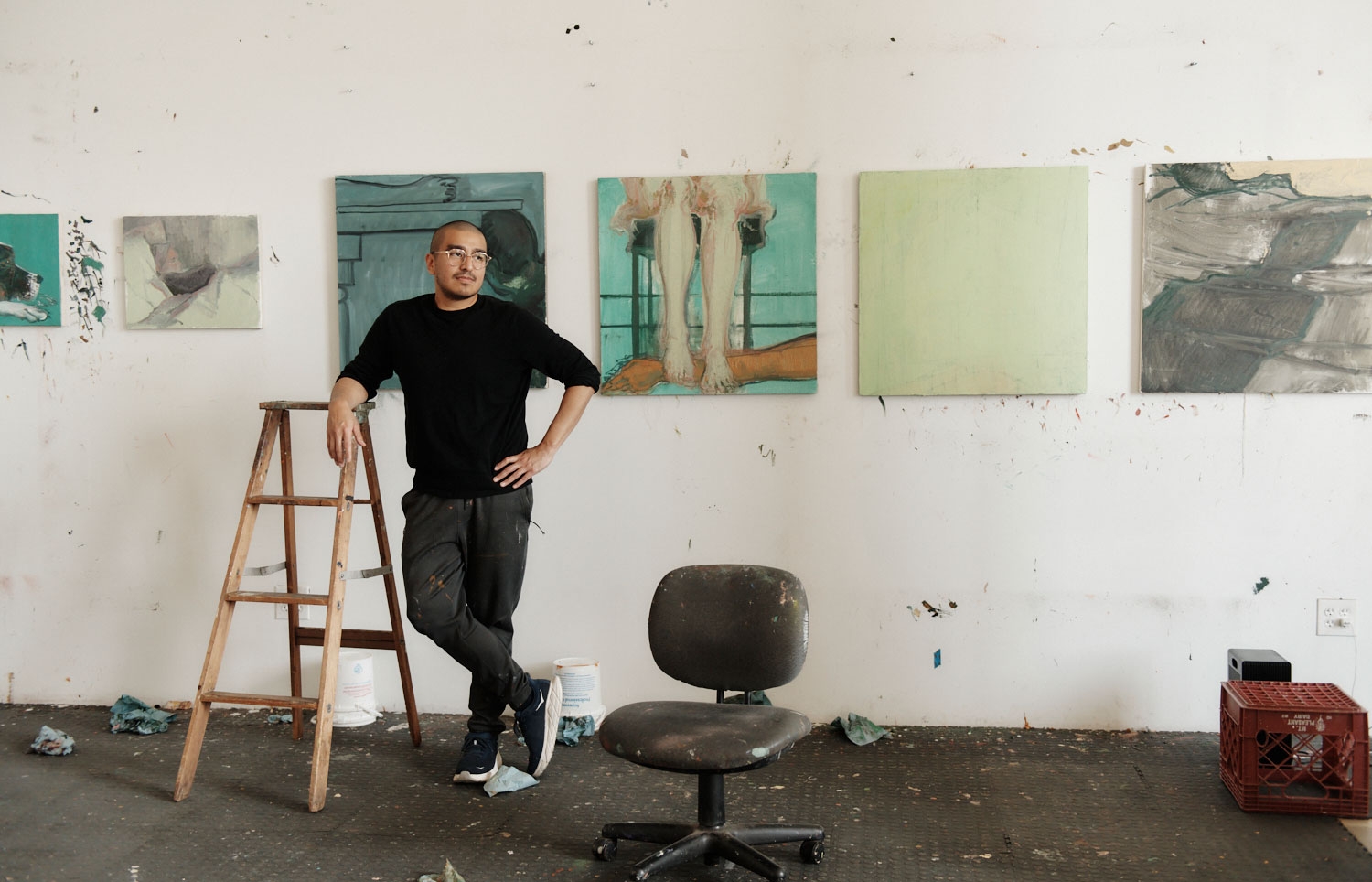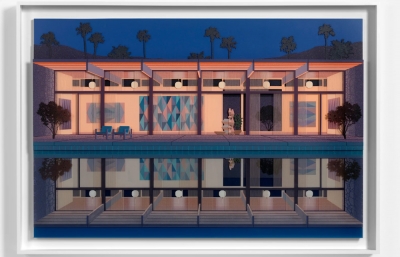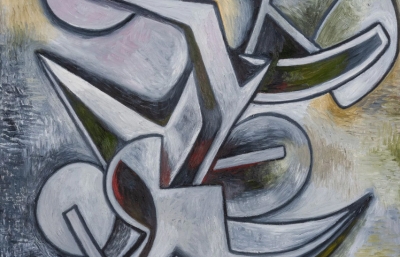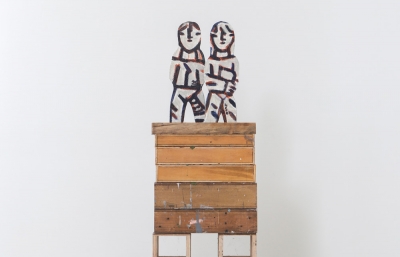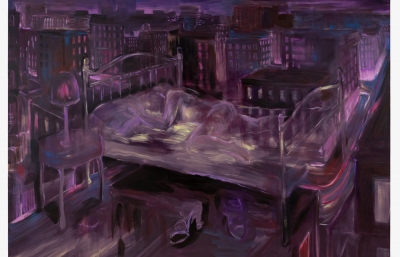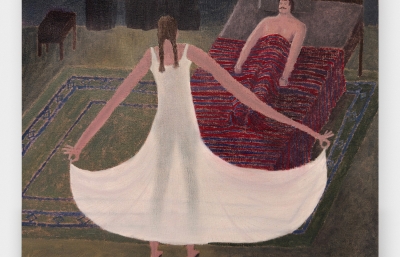Timothy Lai
Painted Syncopation
Interview by Charles Moore // Portrait by Tony Luong
Timothy Lai's paintings are constructed like a dream. While looking at them, I often find myself quite transfixed with the idea that faces sort of drift in and out of the works, that the animals seem to possess a deep clarity, while humans merge in and out of focus. It seems apt that the title of Lai's last solo show at Josh Lilley’s in London was Towards a Blue Room, a nod to Chet Baker, who, too, was able to create notes that seemed to drift and vanish like cigarette smoke in the night. You can hear these paintings but can't quite recognize their origins.
There is something in the idea of covered faces, viewed from behind, and then bared looking back, as adjacent figures embrace, then find themselves alone and trying to hide. The domestic settings in each painting create a narrative of how it is to live with someone, how to interact, and how to hide in one’s own space while also sharing it. I think this is where the jazz reference enters, like the harmony of trumpet, bass, piano and drum, each with their own space to roam but connected to a whole sound. The characters here are themselves, individuals who make something greater by virtue of their relation to each other.

Charles Moore: I'd like to start with getting to know a little bit about where you're originally from. You were born in Malaysia?
Timothy Lai: Yes. I was born in Kota Bharu, in the state of Kelantan, to the northeast of Peninsular Malaysia. We lived about 45 minutes from the border of Thailand.
And it’s where you spent most of your life?
I was raised there. Very candidly, my parents' plan was to only be there for a year, but my grandfather died unexpectedly. My dad, who was then in his master's program, had to leave his studies to help handle the family business and affairs. So that’s where they ended up setting roots. I was there until the age of 17. My mom is from Texas, and once I finished high school, I went to the University of Texas at San Antonio.
From what I hear about Malaysia, it’s a melting pot of cultures. What was your experience growing up there?
Historically, you are correct. Due to the spice trade in the 18th century, Malaysia was a stopover for trading vessels from the Portuguese, Dutch, and British East India Company at ports like Singapore, Penang, and Malacca, where they formed settlements. As the British gained control over the various states in Malaysia, they introduced rubber planting and tin mining and brought in labor from India and China. Both of these groups contributed significantly to the economy. While the main population is Malay, the second largest population is Chinese, followed by Indians and others. So, yes, Malaysia can be considered a melting pot, though in many senses and in my limited experience, the country remains politically and culturally divided. As context, I think growing up there as a biracial individual was complicated.

So how did you fit in as a person of mixed parentage?
I was very conscious of my “otherness,” not being Malay and not Chinese enough to be fully accepted among the Chinese. I don't look East Asian at all, and everyone was hyper aware of my "Americanness.” So it was complicated. There are many aspects that I love and still miss— the food and easy-going lifestyle—but there were many not so great experiences as well.
When I moved to America, there was this tension between the American dream, the land of opportunity and the reality on the ground—feeling like you don’t quite belong—and I still feel like I don’t. It was just, culturally and societally, a difficult path to negotiate.
And so you moved to Texas, I assume, for school?
Yes. I didn’t go directly into art. My BA was in Communication and I minored in Business Administration and International Studies. In my experience, art was a subject that was de-emphasized by the Malaysian education system, while math and science were prioritized. At 17, I felt like I needed to choose a subject that was more applicable to the real world. My parents wanted me to do business studies, so I opted for communication, thinking it would be slightly more creative, and I worked in that field for a while.
Could you discuss any early influences that shaped your artistic vision and how it has evolved—that is, family, museums, viewing art, listening to music, watching film, or reading particular writers?
My mom certainly was a strong influence when I was young. She would encourage me to draw or decorate pieces for Easter or Christmas, such as setting up the nativity scene. I loved the squiggly sheep she drew whenever we had to draw shepherds and their flock. So my first experiences with art had a lot of religious undertones.
But once I was into it, I wanted more education because I saw there was power in what this flat, two-dimensional thing could do. I didn’t really understand, but I was cocky and stupid enough to think I could do it. So, here was this millennial kid starting to scour the internet for art references and influences—just so I could learn more. I had an early pinboard where the algorithm would suggest names to me online. That led me to Robert Motherwell, Rothko, and Joan Mitchell, who is my absolute favorite. For me, Joan Mitchell had this capacity to translate visual language in a way that was accessible and emotional, sort of like a gateway to abstract language that flipped the way I considered representation, form, and subject. Two of my early favorite Mitchell paintings that do this are Hudson River Day Line, 1955, and No Birds, 1987.
When I started taking classes and met some friends in the field, I got exposed to more art, found more community, and started diving deeper and deeper into my own creations. I was drawn to the idea of having a public voice without having to be public myself, if that makes sense.

How do you approach the beginning of a new piece, and how does your creative process unfold from conception to completion?
Earlier, I mentioned having an online Pinboard, where I would save images of art that appealed to me—art history, film, photography, whatever. Sometimes my inspiration came from there. Over the past few years, I became more idea-and-concept driven and would formulate images to support that practice. I would work alongside this archive of things to find compositions that resonated with me and build from there. Usually, the visualization of an idea comes in a very loose way. A loose sketch happens, a tighter sketch happens, and then, if the drawing still holds, it might get “transferred” onto canvas and renegotiated there.
Once worked on canvas, it's a whole different battle—a lot of pushing and pulling to situate and ground the image. I don't really have a full plan. I don't make really tight drawings. I think, for me, a lot of the value is in searching the canvas and coming into that experience. I mean, it's a space of meditation, a space of learning and unlearning—and sometimes forgiving. It takes time to ground the work.
Recently, after this show with Josh Lilley in London, I’ve been trying to flip my process, approach things more organically as opposed to a very linear structure. I’m not letting the concept lead how I make it, but rather following instincts and natural impulses, making things that resonate with me first, even if I don't understand, just following the trail. I’ll review what I've made and try to make sense of it all later. That's a very uncomfortable way of working for me, but I recognize how fruitful it’s been thus far.
Given your experiences growing up in Southeast Asia, living in Texas, and now in the Northeast, your work seems to navigate these various cultural and international themes. How do you perceive your role as an artist in the context of a global cultural dialogue, and how does this perspective influence your creative choices?
I think, as someone who engages in a particular type of figuration, the figure is inherently political and engages in a cross cultural discourse, whether I like it or not. To me, these aren't paintings that are actively trying to be diasporic, not work that seeks my Asianness and longing for home or regretting that I never had the opportunity to learn about my Mexican Americanness. I definitely do not believe that one artistic practice can serve as a monolithic voice for a people. No, nothing of that. These are paintings about being in and experiencing the mood of the present, either in a family structure or in a love relationship. And the fact that it's an interracial relationship makes things even more charged.
Switching the topic, could you elaborate on how color and material influence or contribute to your narrative and aesthetic choices?
In terms of material, I’m particularly interested in the objectness of paint and, thus, have been invested in how oil paint itself functions on the surface. This heavy paint buildup stems from a place of stubbornness, as I do not feel like I have the efficiency to describe what I am rendering. It is the result of a belabored buildup, of negotiating the material, image, and composition of the surface.
Color has an emotional relationship for me. In my earlier works, there was a huge interest in ochres, earth tones, reds, and yellows, grounding the figure in a particular narrative that feels connected to memory, just like a sepia photograph. In the earlier stages of these works, I was trying to figure out how to ground POC figures into a painting, and someone recommended looking at Paul Gauguin as a point of reference. Reviewing his work, I thought it was a necessary conceptual grounding point to choose a palette that was opposite of his view. I used him as someone to work against. I felt that the color choices I made were of this reality, not some hyper romantic exoticism of an experience.
However, when I did the most recent show, I think I was interested in expanding my knowledge and interest in color, so I moved down the color wheel a little, ha! At the time, Chet Baker's rendition of “Blue Room” was playing in my head, and incorporating that into the title held some form of poignancy. So naturally, the work moved from the warm earth tones towards the blues and greens. Strategically, I’ve found that having a dominant color is also a way to carry a show, to build as if it were a running conversation between one work and the next.

You have referenced a few art movements, the abstract expressionists, Francis Bacon, and the European Old Masters. Are there any other artists that hold a particular kinship or influence?
I think in the past year or two, there has been a leaning towards the London School Painters, most notably, Lucian Freud, Leon Kossoff, Frank Auerbach, and Fancis Bacon. But I also cross reference different things. I might look at a photographer or some classical religious painting for composition, but a contemporary work for color, or someone else for material manipulation. I’m pretty fluid.
I think part of the challenge is answering the questions you want to address with your art. Which have been most significant, and how do you overcome them?
I feel the biggest challenge is sustaining a practice and balancing the demands of running a studio. Like, you as a maker have an idea, and after the euphoria of the first painting, you ask yourself what’s next and how you can keep up with and expand upon this thought. So trying to build and go along with the momentum is important. We're all marathon runners, in a way, essentially always in training.
It's a balancing act; it's engaging in the business side of things but also keeping it at bay and not allowing that to interfere with the vulnerability and sensitivity required to do the work. You need to protect yourself and your space. That also means being self-critical and sustaining the push within you to overcome. Burnout is real, and so is market pressure. But it’s crucial not to fall into the trap of producing. I don't want to be cranking out “Timothy Lai’s” mechanically just because the pressure is on me to be productive. I need to be critically engaged with the work all the time. The thing is to keep it fresh, exciting, and open. Not just the work, but you yourself have to contend with all the mental fog that can set in. This is what I tell myself, at least! Sometimes it’s easy to get lost in the sauce, or whatever people say.

One thing I'm very curious about, especially at openings, is how you engage with public reception and critique of your work. Does audience interpretation influence you at all?
This may sound rather cocky, but I am not easily taken in by everything that's said to me at openings, which tend to be these events where everyone is all congratulations and telling you all the good things. I recognize that, and I'm grateful for people taking time to consider, respond, and share their excitement. And, yes, I acknowledge that there's probably truth in some of that. But that's not where a critical discourse is necessarily going to happen. It's a time of congratulations and celebration. So I don't necessarily take all that to heart or let it influence the work or belief in myself.
But in terms of ongoing audience critiques, interpretation and influence, I wish I could say that it doesn't affect me. But that's not the age we live in. Everyone has access to everyone on social media. There is a lot of scope for me to react to responses—some of them impulsive—that people have given, whether I hear them at an opening, on social media,word of mouth or through grapevine gossip.
The moment it is made aware to me, I end up having to contend with it. I take it back to the studio. I have to sit down. I commit to arguing with those points and running them through the wringer to see if there is validity in those compliments or critiques. I go into huge rants and debates with myself. My partner laughs because she often catches me in the shower or in the kitchen while I'm cooking, engaging in this intense hypothetical argument about a certain issue. I really do raise my voice. That's one way I process audience feedback to see if these things hold water or not. Or I might write about it.
We work in isolation, but at the end of the day, when a work is up for public scrutiny, it has a life of its own. People will say things the way they want to. I don't live under a rock, and comments about things will seep in. I just have to be objective and parse them for what is valid and what is just crass or superficial.
I want to talk about two things. Tell me about your most recent show, Towards a Blue Room. And then I also want to hear about one painting in particular, Lovers (Couple in Bed).
Towards a Blue Room was pivotal in its change of focus. Over the past few years, a lot of what I was exploring had to do with the family in terms of its dynamics and hierarchies. For example, the show at the Longlati Foundation in Shanghai was basically about father-son relationships, where positions of hierarchy are flipped or are no longer relevant. The show at Jack Barrett last year continued that exploration with almost an empathetic gesture towards the father figure, understanding his position.
But this particular show, Towards a Blue Room, was more about intimacy. It had a lot to do with my relationship with my partner and sort of where we stand as lovers under the structure of the system we participate in. There were many aspects of the show that looked towards art history and considered the history of figuration and how a representation of my partner and myself functioned within that history.
I was thinking a lot about negotiations too—all these quiet maneuverings within those moments, like when you're in an argument with your partner and you both are going back and forth. Then, once everything is said and done, there’s that 30 second pause, and you’re just staring at each other intensely. That moment felt very poignant to me. Now, that's not the most comprehensive description of what the show was about, but I think these nuances of engagement are what was at the back of my consciousness. So the paintings depict a lot of this interaction between these two figures in a domestic setting as symbolic for a system and how we navigate with each other within that intimate frame.
And for your second part of the question, how did this image of the lovers come about? I think when we talk about figuration as being inherently political, you cannot not think of hierarchy, like who’s dominant and who’s the subservient one, particularly with an interracial couple within an image. One always considers the woman’s whiteness or the man’s brownness in the equation.
But the thing is, no matter how much I try to avoid it, that duality of perception is inherently there. And so, when pursuing the subject of intimacy, the bedroom setting provided the atmosphere to suggest this ambivalence as seen by one lover coming on top of the other. And again, what looks like a kiss, could be interpreted as a bite on the face. To me, this inherent threat recalls a painting of Goya, Saturn Devouring His Son, as the father reacts to a prophecy that one of his sons would overthrow him. Do you know which one I'm talking about? It speaks to this tension between tenderness and a predatory spirit in the closest of human relationships. I’m very interested in that duality.

I also notice that curtains partially conceal some of your nude figures to produce some kind of cloak of privacy. What were you trying to convey with this?
Curtains became an ongoing motif in this show. I was interested in how they function as an intermediary, alongside windows, between interior and exterior. I think by choosing to acknowledge an exterior, it heightens the intensity of the interior spaces that the figures function within. Furthermore, I was curious about the symbolic malleability and the different ways they could function, as something to hide under, or to be used as a veil, an abstraction, or a diffusion. I thought there were a lot of opportunities to explore.
In terms of concealment, I was curious about how we would read these figures under such terms. When we are not privy to their thoughts and actions. I thought it would be exciting to open up the potential to multiple readings and ultimately have no finite answer. Admittedly, from a painterly perspective, it also allowed more room for exploration in material and visual manipulation. It was exciting to consider the figures’ subjectivity under different terms.
As we move forward in the 21st century, how do you envision the evolution of art forms and the global art community's role in addressing the complex challenges of our time, such as climate change, social inequality, and cultural understanding?
Individuals have always made art in response to shifts in politics, culture, and environment. I suspect we will continue to pursue these topics and address them according to the times. That being said, I believe that in a hyperconnected and globalized world, we are in desperate need for spaces and opportunities that are uncensored and allow for criticism and nuanced discourse surrounding these topics. I believe that many topics you bring up are shrouded in nuances of gray, and artists need spaces to champion that exploration and unpacking. I have seen artists punished and censored for speaking up on issues they care about, and I am personally concerned about the future of critical discourse in the art world if it continues. To create and publicly engage is to have a voice that activates a public and provides agency to those without. But what do I know? I’m just a painter pushing dirt and feeling my feelings.
Timothy’s solo show, Towards a Blue Room, was on view this past winter and spring at Josh Lilley in London
Timothylai.com // This interview was originally published in our SUMMER 2024 Quarterly

